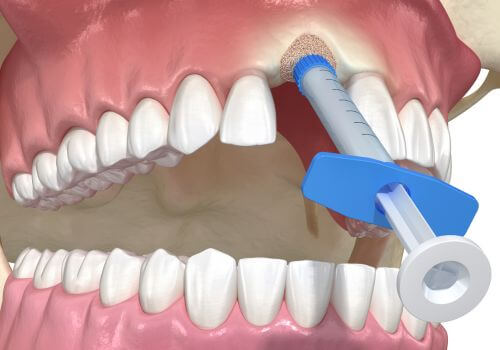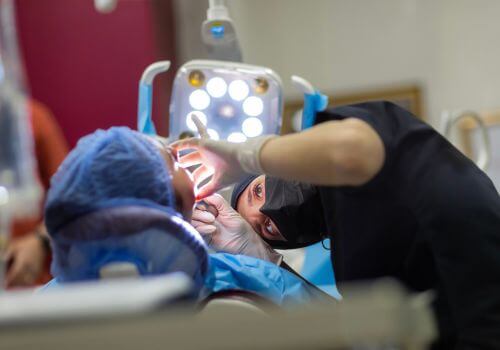Picture this: you’ve just had a tooth removed and feel relieved that the procedure is behind you. Then, your dentist mentions something called a “bone graft.” Suddenly, what seemed like a straightforward extraction becomes more complex, and you may wonder whether a bone graft is really necessary.
You’re not alone. Most patients have questions when bone grafts enter the conversation, and rightfully so. The thought of needing additional treatment can seem daunting, especially when you’re already dealing with a missing tooth.
As dental professionals, we’ve put together this guide to clear up confusion and help you better understand whether you need a bone graft following a tooth extraction.
What Is a Dental Bone Graft?
A dental bone graft is a type of surgery that takes place following an extraction. During the procedure, an oral surgeon replaces missing bone with material from another part of your body or with synthetic material. After a tooth extraction, the jawbone often shrinks in width and height in a process called resorption.
Think of the grafting material as a framework for new bone growth. Over time, your body regenerates bone to replace the graft material, increasing jaw volume and density.

Why Might You Need a Bone Graft After an Extraction?
There are several reasons your dentist may recommend a bone graft following tooth removal:
Preserving Bone Structure
After an extraction, the bone that once supported the tooth no longer receives stimulation from chewing. Without stimulation, the bone deteriorates. A bone graft helps maintain the bone volume and shape of your jaw.
Planning for Dental Implants
Sufficient bone is essential if you’re considering a dental implant to replace your extracted tooth. Implants need solid bone for stability and support, and a bone graft creates an adequate foundation.
As dental professionals, we often recommend socket preservation grafts immediately after extraction when a patient plans to get an implant later. This proactive approach typically saves time and reduces the need for more extensive grafting procedures down the road.
Preventing Facial Structure Changes
Significant bone loss can alter your facial appearance, creating a sunken look that makes you look older. Grafting helps prevent these changes by maintaining proper facial contours.
Support for Adjacent Teeth
When bone deterioration occurs after an extraction, neighboring teeth may shift or become unstable due to the loss of support. A bone graft helps prevent these problems.
Types of Bone Grafts Used After Tooth Extraction
Dentists use several types of bone grafts, each with its own advantages. Your dental team will help determine which is best for you:
-
Autografts: Bone taken from your own body, often from the hip, chin, or jaw. Because it’s your own tissue, it integrates well and supports strong healing.
-
Allografts: Bone from a human donor that has been carefully screened and sterilized for safe use.
-
Xenografts: Bone from animals, usually cows, with all organic material removed, leaving a mineral structure to support new growth.
-
Synthetic grafts: Made from biocompatible materials like calcium phosphate or calcium sulfate, these grafts encourage bone growth without risk of disease transmission.

The Bone Grafting Procedure
Understanding what happens during and after a bone graft can help ease any anxiety about the procedure. Grafting typically occurs immediately after tooth extraction while the socket is exposed.
During a bone graft, your dentist will:
- Clean the extraction site thoroughly.
- Place the grafting material into the socket.
- Cover the graft with a protective membrane.
- Close the gum tissue with stitches.
The entire process usually adds just a few minutes to the extraction procedure.
While recovering from your bone graft, you can expect mild discomfort, swelling, and bruising. These should resolve within a few days. In addition, small bone particles may work their way out through the gum tissue while you heal. This is normal. Complete healing and integration take 3-6 months for most patients, though exact times may vary.
Your dentist will provide aftercare instructions, including how to clean the area, what foods to avoid, and when to schedule follow-up appointments. Following these instructions closely ensures prompt healing and minimizes the risk of complications. If you have any concerns during recovery, contact your dentist right away.
Potential Risks and Complications
Bone grafting is generally safe, but like any surgical procedure, there are some potential risks:
-
Infection: Rare when proper sterilization and techniques are used, but still possible.
-
Graft Failure: Occasionally, the body may not fully integrate the graft material. This is more common in patients who smoke or have certain medical conditions.
-
Nerve Damage: In very rare cases, grafting can affect nearby nerves, leading to temporary or permanent numbness or tingling in the mouth or face.
-
Sinus Complications: For grafts in the upper jaw near the sinus, there’s a small risk of puncturing the sinus membrane.
Your dental team takes every precaution to minimize these risks and will discuss ways to keep your procedure safe and successful.
Do You Need a Dental Bone Graft?
Getting a bone graft after a tooth extraction is an investment in your long-term oral health. While not required for every patient, bone grafts provide important benefits—especially for those planning dental implants or wanting to preserve their facial structure. Your dentist will evaluate your individual situation and help determine if a graft is the right step to support your oral health goals. When performed by skilled professionals, bone grafts are highly successful, and following proper aftercare ensures smooth healing.
Although the idea of a bone graft may feel intimidating, the procedure usually only adds a few minutes to a standard tooth extraction. If you’re facing an extraction, talk to your dentist about whether a bone graft could benefit you.

